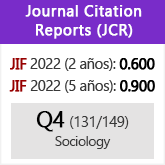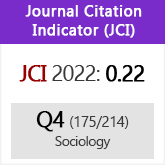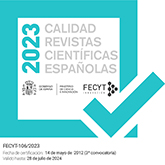El recuerdo de voto en España. Un análisis del período 1996-2008
DOI:
https://doi.org/10.3989/ris.2008.10.17Palabras clave:
Efectos de orden, Encuestas electorales, Error de cobertura, Intención de voto, No respuesta, Trabajo de campoResumen
En este trabajo examinamos el recuerdo de voto recogido por el Barómetro del Centro de Investigaciones Sociológicas (CIS) a lo largo de tres legislaturas. Previamente, identificaremos las posibles fuentes de error que podrían sesgarlo. Nos detendremos en la influencia de las fallas en el proceso de recuperación, el sesgo de deseabilidad social y los efectos del instrumento de medición. Seguidamente daremos cuenta de sus principales sesgos a nivel agregado en España. Comprobaremos que el paso del tiempo introduce sucesivos errores en su declaración y, específicamente, veremos que parte de los entrevistados tendería a reconstruir su recuerdo de voto a partir de su intención de voto presente. Finalmente, prestaremos atención a la posible influencia de factores a corto plazo y al impacto del trabajo de campo. Nuestro objetivo es ayudar a los investigadores que emplean el recuerdo de voto a reconsiderar sus sesgos.
Descargas
Citas
Abelson, Robert P., Elisabeth F. Loftus y Anthony G. Greenwald. 1992. “Attempts to improve the accuracy of self-reports of voting.” Pp.138-153 en Questions about Survey Questions: Meaning, Memory, Expression, and Social Interactions in Surveys, editado por J. Tanur. Nueva York: Russell Sage.
Adamany, David y Philip Dubois. 1975. “The “Forgetful” Voter and an Underreported Vote.” The Public Opinion Quarterly 39: 227-231. doi:10.1086/268219
Andersson, Hans E. y Donald Granberg. 1997. “On the Validity and Reliability of Self-reported Vote: Validity Without Reliability?” Quality & Quantity 31: 127-140. doi:10.1023/A:1004266517584
Anderson, Barbara A. y Brian D. Silver. 1986. “Measurement and Mismeasurement of the Validity of the Self-reported Vote.” American Journal of Political Science 30: 771-785. doi:10.2307/2111272
Atkeson, Lonna R. 1999. ““Sure, I Voted for the Winner!” Overreport of the Primary Vote for the Party Nominee in the National Election Studies.” Political Behavior 21: 197-215. doi:10.1023/A:1022031432535
Barnett, Julie. 1998. “Sensitive questions and response effects: an evaluation.” Journal of Managerial Psychology 13: 63-76. doi:10.1108/02683949810369138
Barton, Allen H. 1958. “Asking the Embarrassing Question.” The Public Opinion Quarterly 22: 67-68. doi:10.1086/266761
Beckett, Megan, Julie Da Vanzo, Narayan Sastry, Constantijn Panis y Christine Peterson. 2001. “The Quality of Retrospective Data: An Examination of Long-Term Recall in a Developing Country.” The Journal of Human Resources 36: 593-625. doi:10.2307/3069631
Belli, Robert F., Michael W. Traugott y Matthew N. Beckmann. 2001. “What leads to Voting Overreports? Contrast of Overreporters to Validated Voters and Admitted Nonvoters in the American National Election Studies.” Journal of Official Statistics 17: 479-498.
Belli, Robert F., Michael W. Traugott, Margaret Young y Katherine A. McGonagle. 1999. “Reducing Vote Overreporting in Surveys: Social Desirability, Memory Failure, and Source Monitoring.” The Public Opinion Quarterly 63: 90-108. doi:10.1086/297704
Belli, Robert F., Sean E. Moore y John VanHoewyk. 2006. “An experimental comparison of question forms used to reduce vote overreporting.” Electoral Studies 25: 751-759. doi:10.1016/j.electstud.2006.01.001
Benewick, Robert, Anthony H. Birch, Jay Blumler y Alison Ewbank. 1969. “The Floating Voter and the Liberal View of Representation.” Political Studies 17: 177-195. doi:10.1111/j.1467-9248.1969.tb00634.x
Bernstein, Robert, Anita Chadha y Robert Montjoy. 2001. “Overreporting Voting: Why it Happens and Why it Matters.” The Public Opinion Quarterly 65: 22-44. doi:10.1086/320036 PMid:11264053
Bradburn, Norman M. y William M. Mason. 1964. “The effect of question order on responses.” Journal of Marketing Research 1: 57-61. doi:10.2307/3150380
Bradburn, Norman M., Seymour Sudman y Brian Wansink. 2004. Asking Questions: the definitive guide to questionnaire design for market research, political polls, and social and health questionnaires. San Francisco: Jossey-Bass.
Brehm, John. 1993. The Phantom Respondents: Opinion Surveys and Political Representation. Ann Arbor: University of Michigan Press.
Calahan, Don. 1968. “Correlates of Respondent Accuracy in the Denver Validity Survey.” The Public Opinion Quarterly 32: 607-621.
Campbell, Angus, Philip E. Converse, Warren E. Miller y Donald E. Stokes. 1980. The American Voter. Chicago: The University of Chicago Press.
Clausen, Aage. 1968. “Response Validity: Vote Report.” The Public Opinion Quarterly 32: 588-606. doi:10.1086/267648
Crespi, Irving y Dwight Morris. 1984. “Question Order Effect and the Measurement of Candidate Preference in the 1982 Connecticut Elections.” The Public Opinion Quarterly 48: 578-591. doi:10.1086/268859
Díaz de Rada, Vidal. 2008. “La selección de los entrevistados últimos en encuestas presenciales: un análisis de la utilización conjunta del método de rutas y el método de cuotas” REIS: Revista Española de Investigaciones Sociológicas 123: 209-247.
Díaz de Rada, Vidal y Adoración Núñez-Villuendas. 2008. Estudio de las Incidencias en la Investigación con Encuesta. El caso de los barómetros del CIS. Colección Monografías 251. Madrid: Centro de Investigaciones Sociológicas.
Dinerman, Helen. 1949. “1948 Votes in the Making – A Preview” The Public Opinion Quarterly 12: 585-598. doi:10.1086/266003
Duff, Brian, Michael J. Hanmer, Won-ho Park y Ismail K. White. 2007. “Good Excuses: Understanding Who Votes with an Improved Turnout Question.” The Public Opinion Quarterly 71: 67-90. doi:10.1093/poq/nfl045
Eubank, Robert B. y David J. Gow. 1983. “The Pro-Incumbent Bias in the 1978 and 1980 National Election Studies.” American Journal of Political Science 27: 122-139. doi:10.2307/2111056
Freeman, Howard E. 1953. “A Note on the Prediction of Who Votes.” The Public Opinion Quarterly 17: 288-292. doi:10.1086/266462
Gow, David J. y Robert B. Eubank. 1984. “The Pro-Incumbent Bias in the 1982 National Election Study.” American Journal of Political Science 28: 224-230. doi:10.2307/2110795
Granberg, Donald y Soren Holmberg. 1991. “Self-Reported Turnout and Voter Validation.” American Journal of Political Science 35: 448-459. doi:10.2307/2111370
Granberg, Donald y Soren Holmberg. 1986. “Prior Behavior, Recalled Behavior, and the Prediction of Subsequent Voting Behavior in Sweden and the U.S.” Human Relations 39: 135-148. doi:10.1177/001872678603900203
Grice, H. Paul. 1975. “Logic and conversation.” Pp. 41-58 en Syntax and semantics, vol 3, editado por P. Cole. y J. Morgan. Nueva York: Academic Press.
Gronke, Paul. 1992. “Overreporting the Vote in the 1988 Senate Election Study: A Response to Wright.” Legislative Studies Quarterly 17: 113-129. doi:10.2307/440084
Groves, Robert M., Stanley Presser. y Sarah Dipko. 2004. “The Role of Topic Interest in Survey Participation Decisions.” The Public Opinion Quarterly 68: 2-31. doi:10.1093/poq/nfh002
Himmelweit, Hilde T., Marianne J. Biberian y Janet Stockdale. 1978. “Memory for past Vote: Implications of a Study of Bias in Recall.” British Journal of Political Science 8: 365-375. doi:10.1017/S0007123400001411
Hochstim, Joseph R. y Dilman M. Smith. 1948. “Area Sampling or Quota Control?-Three Sampling Experiments.” The Public Opinion Quarterly 12: 73-80. doi:10.1086/265922
Holbrook, Allyson L., Melanie C. Green y Jon A. Krosnick. 2003. “Telephone versus face-to-face interviewingof national probability samples with long questionnaires: Comparisons of respondent satisfying and social desirability response bias.” The Public Opinion Quarterly 67: 79–125. doi:10.1086/346010
Holbrook, Allyson L. y Jon A. Krosnick. 2010. “Social desirability bias in voter turnout reports. Test using the item count technique.” The Public Opinion Quarterly 74: 37-67. doi:10.1093/poq/nfp065
Jackman, Simon. 1999. “Correcting Surveys for Non-Response and Measurement Error Using Auxiliary Information.” Electoral Studies 18: 7-27. doi:10.1016/S0261-3794(98)00039-0
Joslyn, Mark R. 2003. “The Determinants and Consequences of Recall Error about Gulf War Preferences.” American Journal of Political Science 47: 440-452. doi:10.1111/1540-5907.00032
Kalton, Graham, Martin Collins y Lindsay Brook. 1978. “Experiments in Wording Opinion Questions.” Applied Statistics 27: 149-161. doi:10.2307/2346942
Kalton, Graham y Howard Schuman. 1982. “The Effect of the Question on Survey Responses: A Review.” Journal of the Royal Statistical Society. Series A 145: 42-73. doi:10.2307/2981421
Karp, Jeffrey A. y Susan Banducci. 1999. “The Impact of Proportional Representation on Turnout: Evidence from New Zeland.” Australian Journal of Political Science 34: 363-377. doi:10.1080/10361149950281
Karp, Jeffrey A. y David Brockington. 2005. “Social Desirability and Response Validity: A Comparative Analysis of Overreporting Voter Turnout in Five Countries.” The Journal of Politics 67: 825-840. doi:10.1111/j.1468-2508.2005.00341.x
Katosh, John P. y Michael W. Traugott. 1981. “The consequences of Validated and self-reported voting measures.” The Public Opinion Quarterly 45: 519-535. doi:10.1086/268685
Katz, Richard S., Richard G. Niemi y David Newman. 1980. “Reconstructing Past Partisianship in Britain.” Bristish Journal of Political Science 10: 505-537. doi:10.1017/S0007123400002362
Kruskal, William y Frederick Mosteller. 1980. “Representative Sampling, IV : The History of the Concept in Statistics.” International Statistical Review 48: 169-195. doi:10.2307/1403151
Levine, Linda J. 1997. “Reconstructing memory for emotions.” Journal of Experimental Psychology 126: 165-177.
Lynn, Peter. 1995. “Evidence of the inaccuracy of quota samples.” Survey Methods Centre Newsletter 15: 20-23.
Lynn, Peter y Roger Jowell. 1996. “How Might Opinion Polls be Improved?: The Case for Probability Sampling.” Journal of the Royal Statistical Society. Series A 159: 21-28. doi:10.2307/2983465
Marcus, Gregory B. 1986. “Stability and change in political attitudes: Observe, recall, and “explain” ”.Political Behavior 8: 21-44. doi:10.1007/BF00987591
Mason, Robert, Virginia Lesser y Michael W. Traugott. 2002. “Effect of Item Nonresponse on Nonresponse Error and Inference.” pp.149-161 en Survey Nonresponse, editado por R. Groves et al. New York: Wiley-Interscience.
McDermid, Robert H. 1989. “The Recall of Past Partisanship: Feeble Memories or Frail Concepts?” Canadian Journal of Political Science 22: 363-375. doi:10.1017/S0008423900001347
McDonald, Hugh E. y Edward R. Hirt. 1997. “When Expectancy Meets Desire: Motivational Effects in Reconstructive Memory.” Journal of Personality and Social Psychology 72: 5-23. doi:10.1037/0022-3514.72.1.5 PMid:9008371
McFarland, Sam G. 1981. “Effects of Question Order on Survey Responses.” The Public Opinion Quarterly 45: 208-215. doi:10.1086/268651
Miller, Mungo. 1952. “The Waukegan Study of Voter Turnout Prediction.” The Public Opinion Quarterly 16: 381-398. doi:10.1086/266400
Moon, Nick. 1995. “The case for quota sampling.” Survey Methods Centre Newsletter 15: 9-12.
Moore, David W. 2002. “Measuring New Types of Question-Order Effects: Additive and Subtractive.” The Public Opinion Quarterly 66: 80-91. doi:10.1086/338631
Moser, Claus y Alan Stuart. 1953. “An Experimental Study of Quota Sampling.” Journal of the Royal Statistical Society. Series A 116: 349-405. doi:10.2307/2343021
Niemi, Richard G., Richard S. Katz y David Newman. 1980. “Reconstructing Past Partisanship: The Failure of the Party Identification Recall Questions.” American Journal of Political Science 24: 633-651. doi:10.2307/2110951
Noelle-Neumann, Elisabeth. 1995. La espiral del silencio. Opinión pública: nuestra piel social. Barcelona: Paidós Ibérica.
Noelle-Neumann, Elisabeth. 1970. “Wanted: Rules for Wording Structured Questionnaires.” The Public Opinion Quarterly 34: 191-201. doi:10.1086/267789
Núñez-Villuendas, Adoración. 2005. “Incidencias de la Entrevista Personal en la investigación mediante Encuesta.” Revista Española de Investigaciones Sociológicas 109: 219-236.
Parry, Hugh J. y Helen M. Crossley. 1950. “Validity of Responses to Survey Questions.” The Public Opinion Quarterly 14: 61-80. doi:10.1086/266150
Plumb, Elizabeth. 1986. “Validation of Voter Recall: Time of Electoral Decision Making.” Political Behavior 8: 302-312. doi:10.1007/BF00988434
Presser, Stanley. 1984. “Is Inaccuracy on Factual Survey Items Item-Specific or Respondent-Specific?” The Public Opinion Quarterly 48: 344-355. doi:10.1086/268830
Presser, Stanley y Michael Traugott. 1992. “Little white lies and social science models: Correlated response errors in a panel Study of Voting.” The Public Opinion Quarterly 56: 77-86. doi:10.1086/269296
Schacter, Daniel L. 1999. “The Seven Sins of Memory: Insights From Psychology and Cognitive Neuroscience.” American Psychologist 54: 182-203. doi:10.1037/0003-066X.54.3.182 PMid:10199218
Schacter, Daniel L. y Chad S. Dodson. 2001. “Misattribution, False Recognition and the Sins of Memory.” Philosophical Transactions of the Royal Society - Biological Sciences 356: 1385-1393.
Schacter, Daniel L., Joan Y. Chiao y Jason P. Mitchell. 2003. “The Seven Sins of Memory: Implications for Self.” Annals New York Academy of Sciences 1001: 226-239. doi:10.1196/annals.1279.012 PMid:14625363
Schaeffer, Nora C. y Stanley Presser. 2003. “The science of asking questions.” Annual Review of Sociology 29: 65-88. doi:10.1146/annurev.soc.29.110702.110112
Schuman, Howard y Stanley Presser. 1996. Questions and Answers in Attitudes Surveys. Thousand Oaks: Sage.
Scheufele, Dietram A. y Patricia Moy. 2000. “Twenty-five years of the spiral of silence: a conceptual review and empirical outlook.” International Journal of Public Opinion Research 12: 3-28. doi:10.1093/ijpor/12.1.3
Shaw, Daron, Rodolfo De la Garza y Jongho Lee. 2000. “Examining Latino Turnout in 1996: A Three-State, Validated Survey Approach.” American Journal of Political Science 44: 332-340. doi:10.2307/2669315
Shoemaker, Pamela J., Martin Eichholz y Elizabeth A. Skewes. 2000. “Item Nonresponse: Distinguishing Between Don”t Know and Refuse.” International Journal of Public Opinion Research 14: 193-201. doi:10.1093/ijpor/14.2.193
Sigelman, Lee. 1982. “The nonvoting voter in voting research.” American Journal of Political Science 26: 47-56. doi:10.2307/2110838
Sigelman, Lee. 1981. “Question-Order Effects on Presidential Popularity.” The Public Opinion Quarterly 45: 199-207. doi:10.1086/268650
Silver, Brian D., Paul R. Abramson y Barbara A. Anderson. 1986. “The presence of others and Overreporting of Voting in American National Elections.” The Public Opinion Quarterly 50: 228-239. doi:10.1086/268977
Silver, Brian D., Barbara A. Anderson y Paul R. Abramson. 1986. “Who Overreports Voting?.” American Political Science Review 80: 613-624. doi:10.2307/1958277
Smith, Tom W. 1984. “Recalling Attitudes: An Analysis of Retrospective Questions on the 1982 GSS.” The Public Opinion Quarterly 48: 639-649. doi:10.1086/268865
Smith, Tom W. 1983. “On the Validity of Inferences from Non-random Sample.” Journal of the Royal Statistical Society. Series A 146: 394-403. doi:10.2307/2981454
Stephenson, C. Bruce. 1979. “Probability Sampling With Quotas: An Experiment.” The Public Opinion Quarterly 43: 477-496. doi:10.1086/268545
Stocké, Volker. 2007. “Response Privacy and Elapsed Time Since Election Day as Determinants for Vote Overreporting.” International Journal of Public Opinion Research 19: 237-246. doi:10.1093/ijpor/edl031
Stocké, Volker y Tobias Stark. 2007. “Political Involvement and Memory Failure as Interdependent Determinants of Vote Overreporting.” Applied Cognitive Psychology 21: 239-257. doi:10.1002/acp.1339
Sudman, Seymour. 1966. “Probability Sampling with Quotas.” Journal of the American Statistical Association 61: 749- 771. doi:10.2307/2282785
Swaddle, Kevin y Anthony Heath. 1989. “Official and Reported Turnout in the British General Election of 1987.” British Journal of Political Science 19: 537-570. doi:10.1017/S0007123400005627
Tourangeau, Roger y Ting Yan. 2007. “Sensitive Questions in Surveys.” Psychological Bulletin 133: 859-883. doi:10.1037/0033-2909.133.5.859 PMid:17723033
Traugott, Michael W. y John P. Katosh. 1979. “Response validity in surveys of voting behavior.” The Public Opinion Quarterly 43: 359-377. doi:10.1086/268527
Urquizu, Ignacio. 2005. “El Voto Oculto en España.” Revista Española de Ciencia Política 13: 119-156.
Van der Eijk, Cees y Broer Niemöller. 1983. “Recall Accuracy and its Determinants.” Acta Politica 14: 289–342.
Voogt, Robert J. 2005. “An alternative Approach to Correcting Response and Nonresponse Bias in Election Research” Acta Politica 40: 94-116. doi:10.1057/palgrave.ap.5500086
Voogt, Robert J. y Hetty Van Kempen. 2002. “Nonresponse Bias and Stimulus Effects in the Dutch National Election Study.” Quality & Quantity 36: 325-345. doi:10.1023/A:1020966227669
Waldhal, Ragnar y Bernt Aardal. 2000. “The accuracy of recalled previous voting: evidence from Norwegian Election Study Panels.” Scandinavian Political Studies 23: 373-389. doi:10.1111/1467-9477.00042
Waldhal, Ragnar y Bernt Aardal. 1982. “Can We Trust Recall-Data?” Scandinavian Political Studies 5: 101-116. doi:10.1111/j.1467-9477.1982.tb00438.x
Weir, Blair T. 1975. “The distortion of voter recall.” American Journal of Political Science 19: 53-62. doi:10.2307/2110693
Weisberg, Herbert F. 2005. The Total Survey Error Approach. Chicago: The University of Chicago Press.
Wright, Gerald C. 1993. “Errors in Measuring Vote Choice in the National Election Studies, 1952-88.” American Journal of Political Science 37: 291-316. doi:10.2307/2111533
Wright, Gerald C. 1992. “Reported Versus Actual Vote: There is a Difference and it Matters.” Legislative Studies Quarterly 17: 131-142. doi:10.2307/440085
Wright, Gerald C. 1990. “Misreports of Vote Choice in the 1988 NES Senate Election Study.” Legislative Studies Quarterly 15: 543-563. doi:10.2307/439896
Wu, Chung-li. 2006. “Vote misreporting and survey context: the Taiwan case.” Issues & Studies 42: 223-239.
Descargas
Publicado
Cómo citar
Número
Sección
Licencia
Derechos de autor 2010 Consejo Superior de Investigaciones Científicas (CSIC)

Esta obra está bajo una licencia internacional Creative Commons Atribución 4.0.
© CSIC. Los originales publicados en las ediciones impresa y electrónica de esta Revista son propiedad del Consejo Superior de Investigaciones Científicas, siendo necesario citar la procedencia en cualquier reproducción parcial o total.Salvo indicación contraria, todos los contenidos de la edición electrónica se distribuyen bajo una licencia de uso y distribución “Creative Commons Reconocimiento 4.0 Internacional ” (CC BY 4.0). Puede consultar desde aquí la versión informativa y el texto legal de la licencia. Esta circunstancia ha de hacerse constar expresamente de esta forma cuando sea necesario.
No se autoriza el depósito en repositorios, páginas web personales o similares de cualquier otra versión distinta a la publicada por el editor.

















